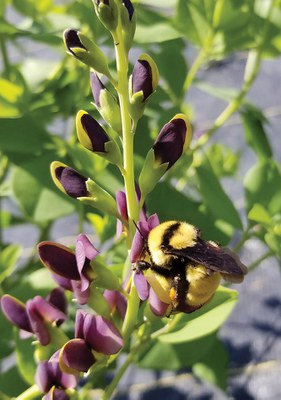Pollinator Preferences for Selected Aster, False Indigo, Bee Balm and Sedum Flowers in North Dakota (H1962, June 2020)
Pollinators are crucial for food production, and more than two-thirds of our leading global food crops rely upon or benefit from pollinators. While pollinators love to visit flowers and feed on pollen and nectar, flowers also add beauty to our yards, farms and natural areas.
The recent dramatic decline of pollinators is a worldwide concern. Some of the major causes of pollinator decline are habitat loss, parasitic pests, pesticides, diseases and climate change. However, homeowners can make a difference in pollinator health by planting perennial flowers in their backyards, providing nesting habitat for bees, and using less toxic pesticides when needed.
Helping Pollinators in North Dakota
North Dakotans want to support pollinators by providing nectar and pollen through planting beautiful flowers in their backyards and farms. Despite the wide availability of many native and ornamental cultivars of perennial flowers, little scientific information is available on whether a flower will be beneficial to pollinators.
Many homeowners are reluctant to plant native species because they are perceived to be less attractive, weedy and more likely to lodge. Consequently, they can have a difficult time selecting perennial flowers that are beautiful in a given setting and will benefit wild bees, bumble bees, honey bees, syrphid flies and butterflies. Having different perennial flowers that bloom throughout the pollinators’ life cycle is important, especially when food is scarce for pollinators, such as early spring and early fall.
This Extension pollinator publication will help determine which perennial flowers to plant that attract and nourish pollinators such as wild bees, bumble bees, honey bees, syrphid flies and butterflies. Eight perennial native species and 20 perennial ornamental cultivars (Table 1 and Figure 1) were observed for their ability to attract pollinators at two locations in southeastern North Dakota.
The genera of perennial flowers tested were Baptisia (wild indigo, false indigo), Hylotelephium (tall sedum), Monarda (bee balm) and Symphyotrichum (aster). Plant hardiness and ornamental landscape potential of these perennials also are discussed.

Difference Between Native Species and Ornamental Cultivars of Perennial Flowers
Native flower species are plants that grow naturally throughout an area or ecoregion and are adapted to the temperature, water, soil, and interactions with other native plants and animals. Ornamental cultivars are flowers that are bred and/or selected to improve characteristics such as flower form, color, fragrance, plant height or disease resistance. Propagation of ornamental cultivars must be through vegetative methods such as division, cuttings or tissue culture because seed propagation could produce different flowers than the parents.
During the breeding process, improved cultivars may lose some of their natural traits that are attractive to pollinators. They even may offer little to no pollen or nectar for pollinators. Native flowers often offer more pollen or nectar because native pollinators have coevolved with these plant species.
Mouthparts of native pollinators have adapted to the structures of native flowers. For example, smaller flowers with shallower nectar reserves, such as asters or milkweeds, will attract smaller bees (sweat bees) or butterflies (hairstreaks) with shorter tongues. Bee balm, with deeper nectar reserves, will attract longer-tongued bees (bumble bees) or butterflies (swallowtails).

Overall Description of Flower Genera Evaluated for Attracting Pollinators (Figure 1)
Baptisia, Hylotelephium, Monarda and Symphyotrichum species commonly are visited by pollinators. Some native species and ornamental cultivars may attract more pollinators, compared with others. However, most of the native and ornamental cultivar flowers tested bloom at different times and were generally attractive to pollinators including wild bees (Figure 2), bumble bees (Figure 3), honey bees (Figure 4), butterflies (Figure 5a-f) and syrphid flies (Figure 6).
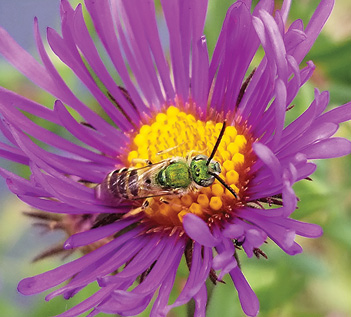
- Figure 2. Wild bee (Halictidae) visiting a Symphyotrichum novae-angliae ‘Purple Dome’ flower. (V. Calles-Torrez, NDSU)
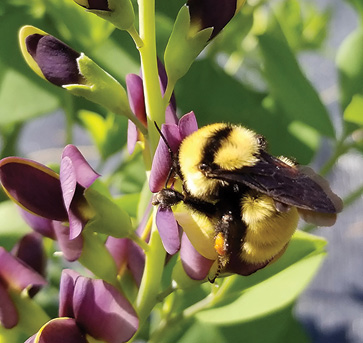
- Figure 3. Bumble bee visiting a Baptisia ‘Indigo Spires’ flower.(V. Calles-Torrez, NDSU)
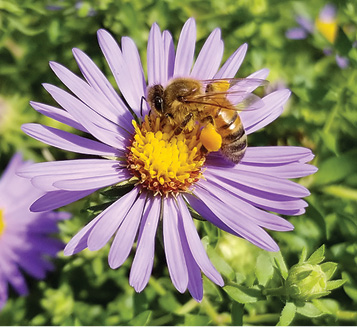
- Figure 4. Honey bee collecting pollen from a Symphyotrichum sp. flower. Note the pollen basket on its hind legs. (V. Calles-Torrez, NDSU)
Figure 5a-f. Different butterflies visiting aster, tall sedum and bee balm flowers. (Photos by V. Calles-Torrez, NDSU)
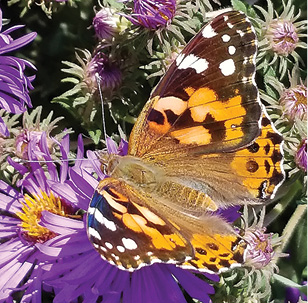
- 5a) Painted lady butterfly visiting a Symphyotrichum novae-angliae flower.
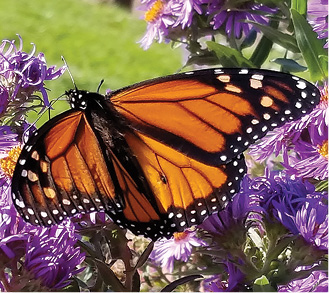
- 5b) Monarch butterfly perching on a Symphyotrichum novae-angliae flower.
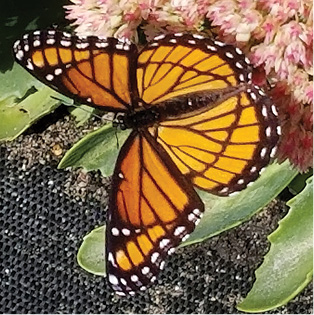
- 5c) Viceroy butterfly perching on a Hylotelephium sp. flower.
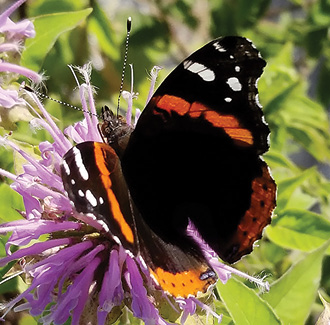
- 5d) Red admiral butterfly visiting a Monarda sp. flower.
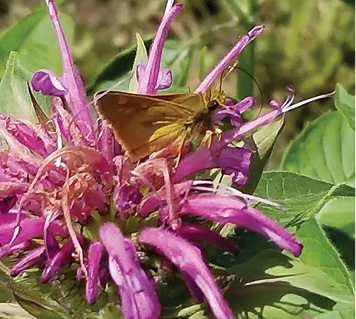
- 5e) Skipper butterfly visiting a Monarda didyma ‘Purple Mildew Resistant’ flower.
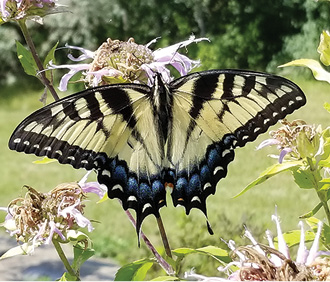
- 5f) Swallowtail butterfly visiting a Monarda fistulosa flower.
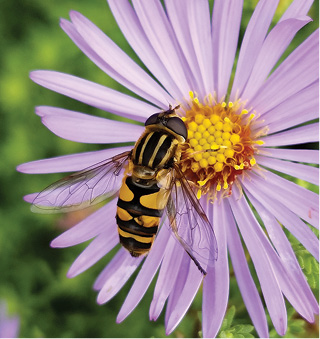
- Figure 6. Syrphid flies visiting a Symphyotrichum sp. flower. (V. Calles-Torrez, NDSU)
Baptisia (wild indigo, false indigo) (Figure 1a-g)
Baptisia belongs to the legume family and has a growth habit that resembles a small shrub with a height range of 2 to 5 feet, depending upon the species or cultivar. Unlike a shrub, the plant dies back to the ground in the winter.
Flowers bloom during June in North Dakota. They have showy pealike flowers and produce multiple flower stems per plant. Flowers can be white, yellow, blue, purple and golden brown.
Baptisia flowers are visited more by bees than syrphid flies and butterflies (Table 1 and Figure 7). Flowers of Baptisia can be a good source of food for wild bees, bumble bees and honey bees during the early season (Figure 8), especially when many other plant species are not yet flowering.
The three native species (Table 1) were slower to establish than ornamental cultivars, and only a small percentage of the native plants bloomed during the one-year study. In contrast, the four cultivars bloomed prolifically during the first year of the study.
This may be attributable to the size of the plants. The cultivars were shipped in 1- or 2-gallon containers from the nursery. In contrast, the native species were generally smaller because they were shipped in much smaller containers and never achieved the same plant size as the larger cultivars.
Due to the lack of flowering during the study, recommendations cannot be given regarding native Baptisia growth and flowering potential or pollinator attraction. Past experience with Baptisia australis shows that this native species may be too large for an ornamental garden, but it may work well in a more naturalized setting.
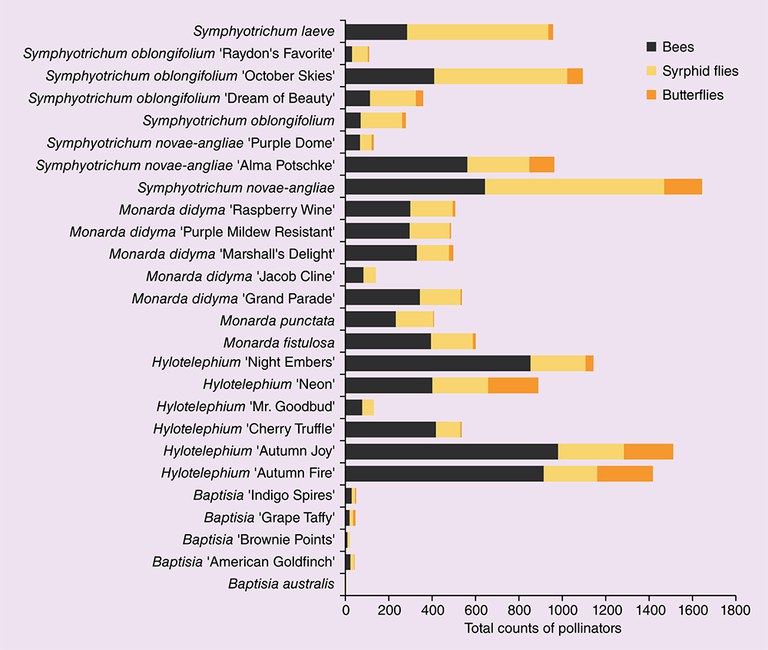
- Figure 7. Pollinators (bees, syrphid flies and butterflies) observed on native species and ornamental cultivars in southeastern North Dakota. Based on 2018 and 2019 data from Fargo and Absaraka, N.D., except for Baptisia, which was based on 2019 data only.
Hylotelephium (tall sedum) (Figure 1h-m)
Ornamental cultivars of tall sedum (Hylotelephium) are a familiar fixture in North Dakota gardens. No sedum species are native to North Dakota. Known for their succulent stems and foliage, they can bloom from August through late September.
Ornamental cultivars of tall sedum produce many large heads of star-shaped flowers. Flower colors can vary from bright pink to mauve to dark red. Foliage color also can range from blue green to dark red.
Overall, most of these cultivars are very heavily visited by bees, syrphid flies and butterflies (Table 1 and Figure 7). Many wild bees and honey bees (Figure 8) frequently visited Night Embers, Autumn Joy and Autumn Fire.
From an ornamental perspective, Neon, Autumn Joy and Autumn Fire were the most attractive. Neon exhibits bright pink flowers and a compact height of approximately 18 inches. Autumn Joy and Autumn Fire grow to 24 inches with dusty pink flowers. Cherry Truffle and Night Embers, received lower landscape ratings because their stems lodged and did not maintain an upright position.
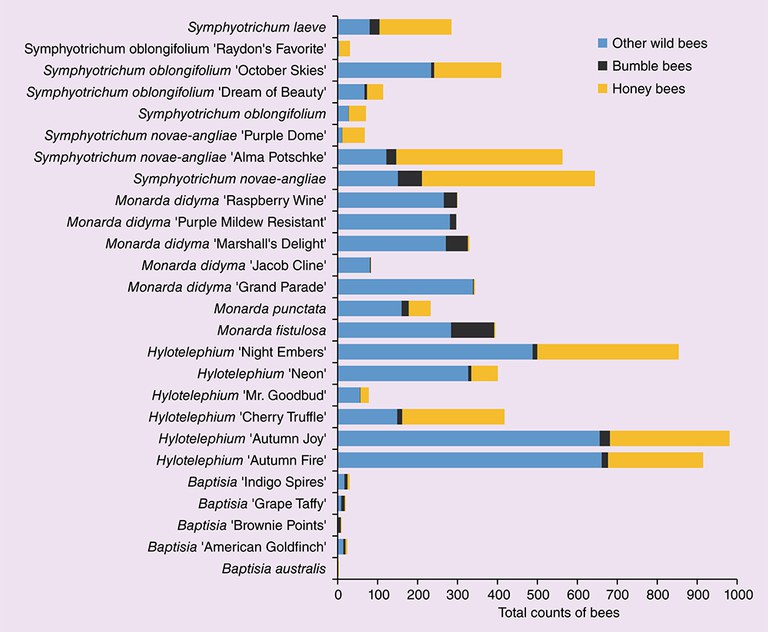
- Figure 8. Bees observed on native species and ornamental cultivars in southeastern North Dakota. Based on the 2018 and 2019 data from Fargo and Absaraka, N.D., except for Baptisia, which was based on 2019 data only.
Monarda (bee balm) (Figure 1n-t)
The genus Monarda belongs to the mint family and has square stems and fragrant foliage. Flowers bloom from July through September, depending upon species and cultivars. Bee balm flowers display diverse colors including pink, red, magenta and yellow-green.
Bee balm flowers were visited frequently by many different bees, followed by syrphid flies and then butterflies (Figure 7). Most bee balm plants are a good food source for long-tongued wild bees and bumble bees (Figure 8).
The native species, Monarda fistulosa, shows severe susceptibility to powdery mildew diseases in North Dakota. In addition, its size (48 inches tall) may limit its use in gardens.
Monarda punctata was quite attractive, but most plants did not survive the first winter. This species may be longer-lived on sandier soils.
Of the cultivars, Grand Parade has the most landscape potential. Its compact height (18 inches), upright stems and attractive purple flowers make it an all-star for the summer garden.
Symphyotrichum (aster) (Figure 1u-bb)
Asters recently have been assigned to the genus Symphyotrichum and have much diversity in growth habit and flower color. This group blooms from late August until the first heavy frost.
Flowers can be light to dark pink, light to dark purple and even light blue like a robin’s egg. In North Dakota, these perennial flowers often will not complete flowering due to the cold temperatures in early fall.
However, these late-season perennial flowers are good sources of food for pollinators, especially because the availability of food for honey bees, bumble bees and migrating butterflies such as the monarch are scarce in early fall. Bees need to store plenty of food in their honey hives or nests to survive the winter season.
Aster flowers (Table 1 and Figures 7 and 8) are mostly visited by bees (Figure 9) and syrphid flies (Figure 10). Butterflies also will visit these flowers, but less frequently than bees and syrphid flies. The native species Symphyotrichum novae-angliae (New England Aster) and its cultivar, Alma Potschke, were heavily visited by honey bees (Figure 8).
Alma Potschke and Purple Dome are cultivars of Symphyotrichum novae-angliae. The native species is 5 feet tall, lanky and sprawling in appearance. Alma Potschke, with its magenta-colored flowers, is shorter at 42 inches, but still may need staking to prevent stem lodging.
Purple Dome has a more compact growth habit of 30 inches with very attractive purple flowers. In years with early heavy frosts, cold temperatures may cause Purple Dome to go dormant before reaching full bloom. During the study, Purple Doom started to bloom in late September in southeastern North Dakota. However, it is a spectacular plant in years when frost is delayed.
Dream of Beauty, October Skies and Raydon’s Favorite are cultivars of the native species Symphyotrichum oblongifolium (aromatic aster). Symphyotrichum oblongifolium and the cultivar Raydon’s Favorite bloom too late in the fall to be reliable for pollinators in North Dakota.
Dream of Beauty has light pink flowers and fits in the smallest gardens at only 18 inches tall. October Skies blooms later than Dream of Beauty and has light blue flowers. The growth habit of October Skies is more like a short shrub and grows to 2 feet tall and 4 to 5 feet wide.
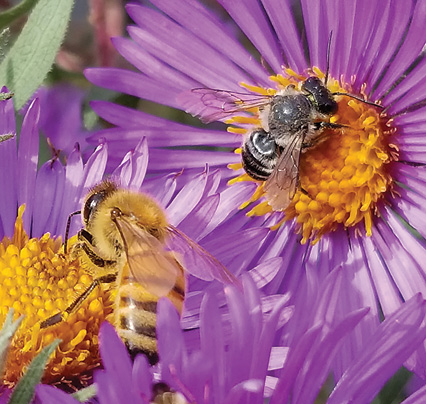
- Figure 9. Honey bee (on the left side) and wild bee (on the right side) collecting pollen from a Symphyotrichum novae-angliae flower. (V. Calles-Torrez, NDSU)
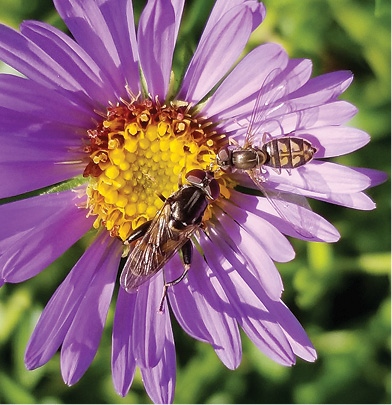
- Figure 10. Two different syrphid flies visiting a Symphyotrichum sp. flower. (V. Calles-Torrez, NDSU)
Conclusions
A mix of flowering perennials are recommended to ensure the presence of food for pollinators from spring through late fall. While other studies have shown that native species provide excellent forage for bees, this research project shows that certain ornamental cultivars also can be beneficial to pollinators. Ornamental cultivars and native species can be integrated into pollinator gardens and landscapes to improve the aesthetics as well as attract and nourish pollinators.![]()
![]()
![]()
![]()
![]()
![]()



Printing of this publication is supported in part by the U.S. Department of Agriculture - North Dakota Department of Agriculture Specialty Crop Block Grant Program and the Great Plains Diagnostic Network grant under a subcontract from the U.S. Department of Agriculture, National Institute of Food and Agriculture.
.png)
NDSU Extension does not endorse commercial products or companies even though reference may be made to tradenames, trademarks or service names.

